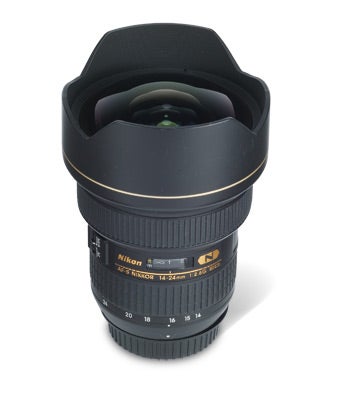Nikon's 14-24mm f/2.8G ED AF-S lens is a fast, ultra-wideangle zoom designed for full-frame cameras like the D3 and D700.
Nikon AF-S 14-24mm f/2.8G ED Review
Flare Reduction
One of the problems producing extreme wideangle zoom lenses is that the curvature of the front element is perfectly suited for catching flare, especially when you are shooting towards the sun.
One way of overcoming this is always to shoot away from the sun, but that’s not practical if the subject is in the other direction or the sun is within the wide angle of view. To aid in reducing flare and ghosting, Nikon has developed Nano Crystal coatings with a very low refractive index to cut down on the reflection of these stray light around the internal elements of the lens.
Originally developed for Nikon semi-conductors, the coating is composed of several layers of ultra fine crystal particles, ranging in size from just a few nanometers to no more than 10 nanometers, according to Nikon. This provides extremely high anti-reflection performance over a wide wavelength range, surpassing the levels of traditional anti-reflection coatings. Nikon says its beneficial effect on flare and ghosting caused by oblique incident light to the lens is unprecedented.
Other Features
Needless to say, this lens features this, along with an SWM motor for fast autofocusing and at f/2.8 it is the fastest superwide zoom in its class. The optical train consists of 14 elements in 11 groups and includes two ED glass elements and three aspherical elements and offers a viewing angle of 144-84° on a full frame format. If used on an APS-C camera, the focal length equivalent shift would provide the same angle of view as a 21-36mm lens. Additionally, the lens comes complete with an integrated lens hood while its bulbous front prohibits the use of filters of any sort.
Image Quality
The lens is big and bulky at 970g, but the quality of glass speaks for itself. The lens performs extremely well, with sharp images and little sign of fringing in normal or high-contrast conditions. Even with harsh, low-lying sunlight entering the lens, there is no visible sign of flare or ghosting, while vignetting when used on the Nikon D3 is also hard to see.
There is some distortion at both ends of the lens focal length, especially in the 14mm range, but this is to be expected on a lens this wide. However, it is as flat field as it gets, with none of the pronounced curvature of an 11mm fisheye.
Verdict
It’s not cheap but it’s a hell of a hunk of glass, so expect at least £1,200 on the street. It’s also not the most practical lens, though the 24mm is slightly more sensible. It is a remarkable piece of kit though, and a very desirable optic for extreme wideangle enthusiasts.





